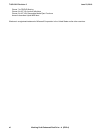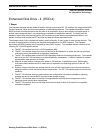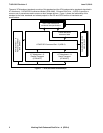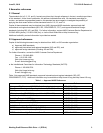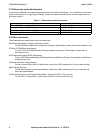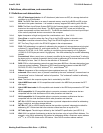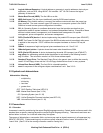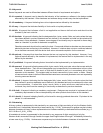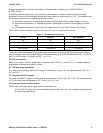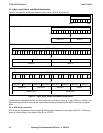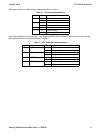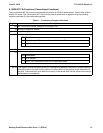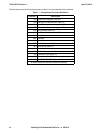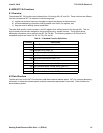T13/2132-D Revision 3 June 23, 2010
8 Working Draft Enhanced Disk Drive - 4 (EDD-4)
3.3.4 Keywords
Several keywords are used to differentiate between different levels of requirements and options.
3.3.4.1 expected: A keyword used to describe the behavior of the hardware or software in the design models
assumed by this standard. Other hardware and software design models may also be implemented.
3.3.4.2 mandatory: A keyword indicating items to be implemented as defined by this standard.
3.3.4.3 may: A keyword that indicates flexibility of choice with no implied preference.
3.3.4.4 N/A: A keyword that indicates a field is not applicable and has no defined value and should not be
checked by the host or device.
3.3.4.5 obsolete: A keyword indicating that the designated bits, bytes, words, fields, and code values that may
have been defined in previous standards are not defined in this standard and shall not be reclaimed for
other uses in future standards. However, some degree of functionality may be required for items desig-
nated as “obsolete” to provide for backward compatibility.
Obsolete commands should not be used by the host. Commands defined as obsolete may be command
aborted by devices conforming to this standard. However, if a device does not return command aborted
for an obsolete command, then the device shall return command completion for the command.
3.3.4.6 optional: A keyword that describes features that are not required by this standard. However, if any
optional feature defined by the standard is implemented, the feature shall be implemented in the way
defined by the standard.
3.3.4.7 prohibited: A keyword indicating that an item shall not be implemented by an implementation.
3.3.4.8 reserved: A keyword indicating reserved bits, bytes, words, fields, and code values that are set aside for
future standardization. Their use and interpretation may be specified by future extensions to this or other
standards. A reserved bit, byte, word, or field shall be cleared to zero, or in accordance with a future
extension to this standard. The recipient shall not check reserved bits, bytes, words, or fields. Receipt
of reserved code values in defined fields shall be treated as a command parameter error and reported by
returning command aborted.
3.3.4.9 retired: A keyword indicating that the designated bits, bytes, words, fields, and code values that had
been defined in previous standards are not defined in this standard and may be reclaimed for other uses
in future standards. If retired bits, bytes, words, fields, or code values are used before they are
reclaimed, they shall have the meaning or functionality as described in previous standards.
3.3.4.10 shall: A keyword indicating a mandatory requirement. Designers are required to implement all such
mandatory requirements to ensure interoperability with other products that conform to this standard.
3.3.4.11 should: A keyword indicating flexibility of choice with a strongly preferred alternative. Equivalent to the
phrase “it is recommended”.
3.3.5 Numbering
A binary number is represented in this standard by any sequence of digits consisting of only the Western-Arabic
numerals 0 and 1 immediately followed by a lower-case b (e.g., 0101b). Underscores or spaces may be included
between characters in binary number representations to increase readability or delineate field boundaries (e.g., 0
0101 1010b or 0_0101_1010b).
A hexadecimal number is represented in this standard by any sequence of digits consisting of only the
Western-Arabic numerals 0 through 9 and/or the upper-case English letters A through F immediately followed by
a lower-case h (e.g., FA23h). Underscores or spaces may be included between characters in hexadecimal



